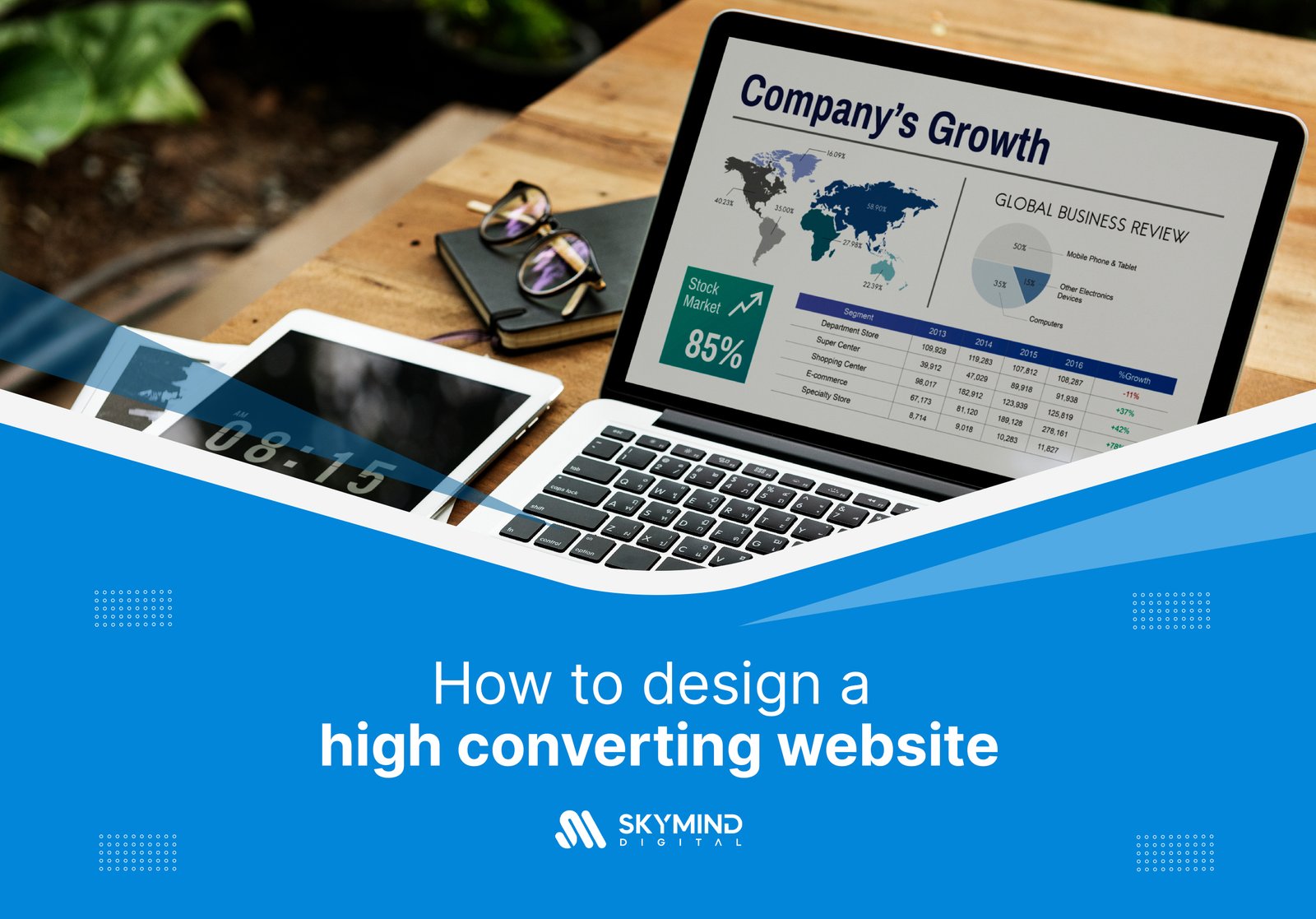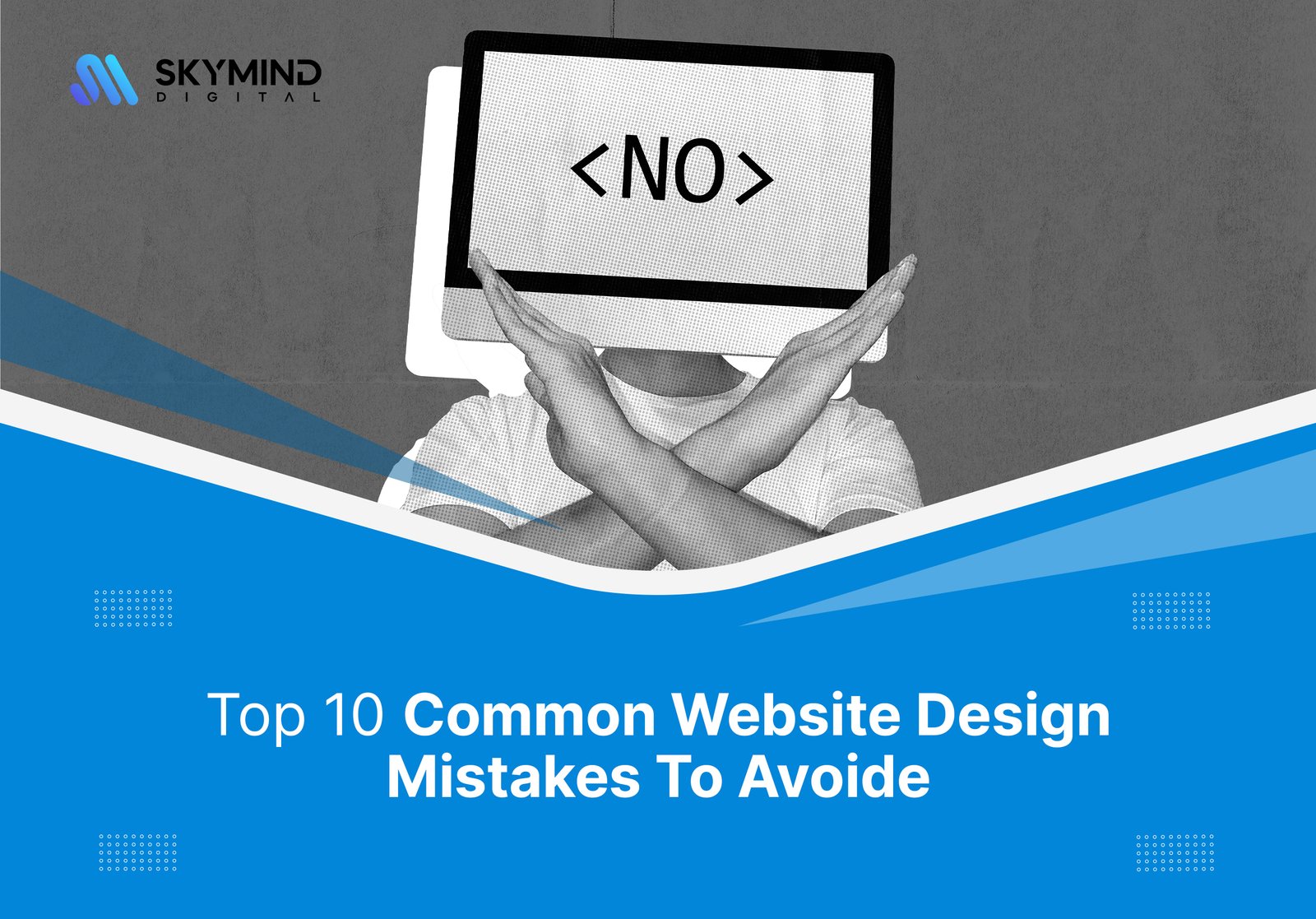In today’s competitive digital landscape, a website is more than just an online presence—it’s a critical sales tool. Businesses with high converting websites consistently outperform their competitors, turning visitors into loyal customers and driving revenue growth.
Studies show that websites optimized for conversion can increase sales by up to 20-30% compared to those with basic designs.
Designing a website that converts involves more than aesthetics. According to a report by HubSpot, 76% of consumers say usability is the most important factor in website design.
A well-structured, conversion-focused website not only enhances user experience but also builds trust, encouraging visitors to take action—whether that’s making a purchase, filling out a form, or signing up for a newsletter.
This blog will explore how to design a website that converts, focusing on proven strategies, essential elements, and actionable tips. From mobile-friendly layouts to engaging CTAs, we’ll uncover the secrets behind websites that convert and help you maximize sales.
Let’s dive into the world of high converting websites and transform your site into a revenue-generating machine!
Understanding Conversion for Websites
In web design, “conversion” refers to the desired actions users take on your website—such as making a purchase, signing up for a newsletter, or filling out a contact form. A highly converting website is one that consistently motivates visitors to complete these actions, transforming casual browsers into loyal customers.
Key performance metrics like conversion rates and bounce rates play a crucial role in measuring a website’s success. Conversion rate, the percentage of visitors who complete a desired action, is a direct indicator of how effective your website is. On the other hand, a high bounce rate (when visitors leave without interacting) often signals design or content issues.
Data shows that websites with well-optimized user experiences see conversion rates increase by 200% or more, according to Forrester Research.
Why does this matter? Websites that convert drive business growth by maximizing the value of your web traffic.
Research from WordStream reveals that even a 1% improvement in conversion rate can significantly impact revenue for e-commerce sites.
A high converting website ensures you’re making the most of your marketing efforts, capturing leads, and closing sales efficiently.
By understanding what conversion means and tracking these metrics, you’ll have the insights needed to create websites that convert and generate maximum sales.
Key Features of Websites That Convert
Creating websites that convert requires more than just a visually appealing design. It’s about blending user-focused features with technical precision to drive action.
Let’s break down the essential features that make a website successful.
1. User-Friendly Navigation
Imagine walking into a store with no signage or directions—it’s confusing, right? The same applies to your website. Easy-to-navigate menus and intuitive layouts help users find what they’re looking for quickly.
A study by Clutch found that 94% of users said website navigation was critical for their decision-making process. Clear menu bars, breadcrumbs, and internal links create a seamless browsing experience.
2. Fast Loading Speeds
Did you know that a one-second delay in page load time can reduce conversions by 7%?
Speed matters. Research by Google shows that 53% of mobile users abandon a site if it takes more than three seconds to load. Use tools like Google PageSpeed Insights to optimize loading times. Compress images, minimize code, and leverage caching to ensure users stay engaged.
3. Mobile Responsiveness
With 59% of global website traffic coming from mobile devices (Statista, 2023), mobile responsiveness isn’t optional—it’s essential.
A mobile-friendly website ensures users have a positive experience on any device. Features like responsive design, readable fonts, and touch-friendly buttons can significantly boost user engagement and conversions.
4. Clear and Compelling CTAs
Every website that converts has one thing in common: strong calls-to-action (CTAs). Whether it’s a “Buy Now” button or a “Sign Up Today” form, CTAs should stand out. Market research indicates that having a clear CTA can increase conversion rates by 80% (WordStream). Use action-oriented language and strategic placement to guide users toward their next step.
By incorporating these features, you’ll not only improve user experience but also build websites that convert. Start by focusing on what your audience needs, and let data guide your decisions.
Examples of Highly Converting Websites
To understand what makes websites that convert, let’s explore real-world examples of highly converting websites. These businesses have mastered design, usability, and strategy to drive outstanding results.
- Amazon
Amazon is the gold standard of e-commerce conversions, with a conversion rate of 9.87% on desktop (Statista, 2023).
Its success lies in personalization—recommendation algorithms, user-specific deals, and a simple checkout process. The “Buy Now” button and one-click purchasing options reduce friction and encourage impulse buys.
- Dropbox
Dropbox’s clean and minimalistic homepage is designed to convert. With a bold headline, clear value proposition, and a “Sign Up for Free” CTA above the fold, the website simplifies decision-making.
According to Unbounce, Dropbox achieved double-digit conversion rates after redesigning their landing pages with clearer messaging.
- Airbnb
Airbnb exemplifies user-friendly navigation and trust-building elements. The homepage prominently features a search bar and enticing imagery, making it easy for users to explore options.
According to SimilarWeb, Airbnb’s bounce rate is significantly lower than competitors, thanks to its intuitive design and personalized content.
These highly converting websites excel because they understand their audience’s needs and prioritize usability. By studying their strategies, you can implement similar tactics to create websites that convert.
Planning Your High Converting Website
Researching Your Target Audience
The foundation of how to design a website that converts lies in understanding your audience. Without clear insights into who you’re targeting, your website may fail to meet their needs.
According to Think with Google, businesses that leverage audience data see 2x more revenue growth compared to those that don’t. Start by identifying key demographics, preferences, and behaviors. Create buyer personas to visualize your ideal customers.
To analyze customer behavior, use tools like Google Analytics for traffic insights and Hotjar for heatmaps and session recordings. These tools reveal what users are clicking, where they’re hesitating, and how they interact with your site.
By tailoring your design to their preferences, you’re one step closer to a high-converting site.
Setting Goals for Your Website
Every high converting website begins with clear, measurable goals. Vague objectives like “get more traffic” won’t cut it. Instead, focus on specific outcomes like increasing newsletter sign-ups by 20% or boosting product sales by 15% within three months.
Data from HubSpot shows that goal-oriented websites are 30% more likely to improve conversions. Your design choices—such as CTA placement, forms, and navigation—should align with these goals. For instance, if lead generation is your priority, feature a prominent signup form on your homepage.
Aligning goals with design ensures every element of your website works toward achieving results.
Structuring Your Website for Maximum Conversions
A high converting website isn’t built randomly—it follows a strategic structure. Planning starts with creating a sitemap, which outlines the hierarchy of your pages. A clear sitemap ensures users can navigate effortlessly, reducing bounce rates.
Wireframes are equally important. These visual blueprints help you plan layouts, ensuring key elements like CTAs, images, and headlines are placed optimally.
According to GoodFirms, 50% of users leave a website due to poor structure and navigation.
For instance, placing your primary CTA above the fold can increase engagement by 70% (Crazy Egg). Organize your pages based on user priorities. Homepages should grab attention, product pages should highlight benefits, and landing pages should lead users to act.
With a well-structured website, you’ll guide visitors seamlessly through their journey, improving the likelihood of conversion.
Design Principles for High Converting Websites
Visual Design That Converts
Visual design plays a critical role in creating highly converting websites. It’s not just about aesthetics; visuals directly influence trust and engagement. Research by Adobe found that 38% of people will stop engaging with a website if the content or layout is unattractive.
Whitespace is your friend. It improves readability and makes your content feel organized. For example, Apple’s website uses whitespace strategically to draw attention to product details and CTAs, creating a clean, professional look.
Color psychology is equally important. Colors evoke emotions and guide actions. For instance, blue builds trust, while red creates urgency. According to Kissmetrics, using the right colors can boost conversions by up to 24%.
Finally, typography matters. Choose fonts that are easy to read and consistent with your brand identity. Headlines should be bold and clear, while body text remains simple and legible. Consistency across pages reinforces a cohesive user experience.
Optimizing Above-the-Fold Content
The content users see first—above the fold—sets the tone for their entire experience. For websites that convert, this space must deliver immediate value.
Include a compelling headline that grabs attention and communicates your value proposition. A statistic from Crazy Egg shows that 80% of users focus on above-the-fold content. Pair your headline with an engaging visual, such as an image or hero video that resonates with your audience.
Place a clear CTA (Call-to-Action) prominently. Whether it’s “Start Free Trial” or “Shop Now,” make it impossible to miss. This immediate focus on action helps retain visitors and encourages them to explore further.
Creating Clear and Compelling CTAs
A high converting website uses CTAs strategically to guide users toward specific actions. A well-crafted CTA can increase conversions dramatically—WordStream reports that optimizing CTAs can boost click-through rates by up to 80%.
Keep it simple and actionable. Use phrases like “Get Started” or “Claim Your Discount” that encourage users to act immediately. Avoid generic terms like “Submit.”
Strategic placement is key. Position CTAs where users are most likely to click, such as the top of the homepage, at the end of blog posts, or in the checkout process. Data from HubSpot shows that CTAs placed on landing pages with clear intent increase conversions by 20%.
Design matters too. Use contrasting colors to make the CTA stand out from the surrounding content. Adding urgency, like “Limited Time Offer,” can also motivate users to act quickly.
With compelling CTAs, you can turn passive visitors into active customers, driving better results for your website.
Building Trust Through Social Proof
Trust is a critical factor in website conversions. According to Nielsen, 92% of people trust recommendations from peers over other forms of advertising. By incorporating social proof into your design, you can reassure visitors that they’re making the right decision.
Here are some effective ways to add social proof:
- Testimonials and Reviews: Display quotes from satisfied customers prominently on your homepage or product pages. Consider including photos or videos of real users for added credibility.
- Case Studies: Showcase detailed examples of how your product or service solved a problem for your customers.
- Trust Badges: Logos of certifications, awards, or affiliations can signal reliability and professionalism.
- User-Generated Content: Encourage customers to share their experiences on social media and feature these posts on your website. Platforms like Instagram provide seamless integration options.
For instance, companies like Glossier and Airbnb highlight user-generated photos and reviews to build trust and authenticity. When visitors see proof of your credibility, they’re more likely to take action on a high converting website.
Simplifying the Checkout Process
A complicated checkout process is one of the biggest barriers to conversions. In fact, Baymard Institute reports that the average cart abandonment rate is nearly 70% due to lengthy or confusing checkouts.
Here’s how to simplify and optimize the checkout process:
- Enable Guest Checkout: Not all users want to create an account. Allow them to complete purchases without unnecessary steps.
- Streamline Form Fields: Ask only for essential information. Autofill features and address lookup tools can speed up the process.
- Offer Multiple Payment Options: Include popular payment methods like credit cards, PayPal, and digital wallets to cater to diverse customer preferences.
- Display Progress Indicators: If your checkout process spans multiple pages, show users their progress to reduce anxiety and frustration.
- Provide Clear Error Messages: Ensure that error messages are easy to understand and guide users to correct mistakes without hassle.
Amazon excels in simplifying its checkout process, with features like one-click purchasing and saved payment details. By reducing friction, you’ll increase the likelihood of completed transactions on your high converting website.
Incorporating Analytics for Continuous Improvement
Designing a high converting website isn’t a one-time task. Continuous optimization based on analytics is key to staying ahead.
Start by setting up tools like:
- Google Analytics: Track user behavior, conversion rates, and traffic sources.
- Hotjar: Use heatmaps and session recordings to understand how visitors interact with your website.
- A/B Testing Tools: Platforms like Optimizely or VWO allow you to test different versions of pages or elements (e.g., CTAs, headlines) to determine what works best.
For example, an e-commerce site might test whether a red or green “Add to Cart” button leads to higher clicks. By analyzing the data, you can make informed decisions to improve performance and boost sales on your website.
Creating a Content Strategy That Converts
Content is the backbone of a high converting website. Informative and engaging content keeps visitors interested and drives them to act.
Focus on these content types:
- Blog Posts: Regularly publish SEO-optimized posts that address common questions or challenges faced by your audience.
- Product Descriptions: Write detailed and benefit-focused descriptions that highlight the unique value of your offerings.
- Videos: Incorporate explainer videos, product demos, or customer stories to convey your message quickly and effectively.
- Landing Pages: Design dedicated landing pages for campaigns, with targeted messaging and a single, clear CTA.
For instance, HubSpot’s blog consistently attracts leads by providing actionable advice tailored to its target audience. By delivering value through your content, you’ll build trust and encourage conversions on your site.
Enhancing Post-Sale Engagement
The relationship with your customers doesn’t end after a sale. A high converting website also fosters loyalty and repeat business through post-sale strategies.
- Thank You Pages: After a purchase, use thank-you pages to upsell complementary products or invite customers to join your loyalty program.
- Follow-Up Emails: Send personalized emails to thank customers, provide order updates, and suggest related products.
- Customer Feedback: Solicit reviews or feedback to improve your offerings and show customers you value their opinions.
- Retargeting Campaigns: Use retargeting ads to remind past visitors about products they viewed or offer exclusive discounts to encourage return purchases.
Brands like Sephora excel in post-sale engagement by combining email marketing, loyalty rewards, and retargeting to drive repeat business. Happy customers are more likely to become loyal advocates, amplifying your website’s impact and conversion rate.
Conclusion: Transform Your Website into a Conversion Powerhouse
Designing a high converting website requires a strategic blend of user-focused design, compelling content, and continuous optimization. From simplifying navigation to building trust through social proof, every element plays a role in driving conversions and maximizing sales.
Remember to:
- Understand your audience and tailor your design to their preferences.
- Set clear goals and align every element with your objectives.
- Optimize key features like CTAs, mobile responsiveness, and checkout processes.
- Use analytics to make data-driven improvements.
By implementing these strategies, you can create a website that doesn’t just attract visitors but also turns them into loyal customers. Ready to boost your sales? Start optimizing your website today and watch your conversions sore or just reach out to Sky Mind Digital for your design solutions!







